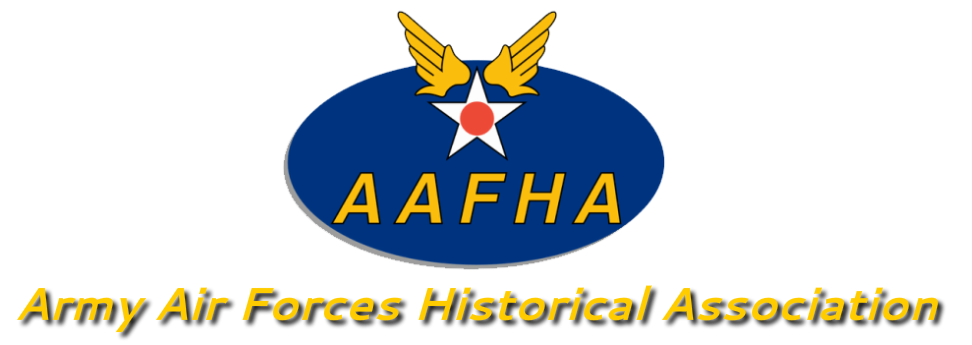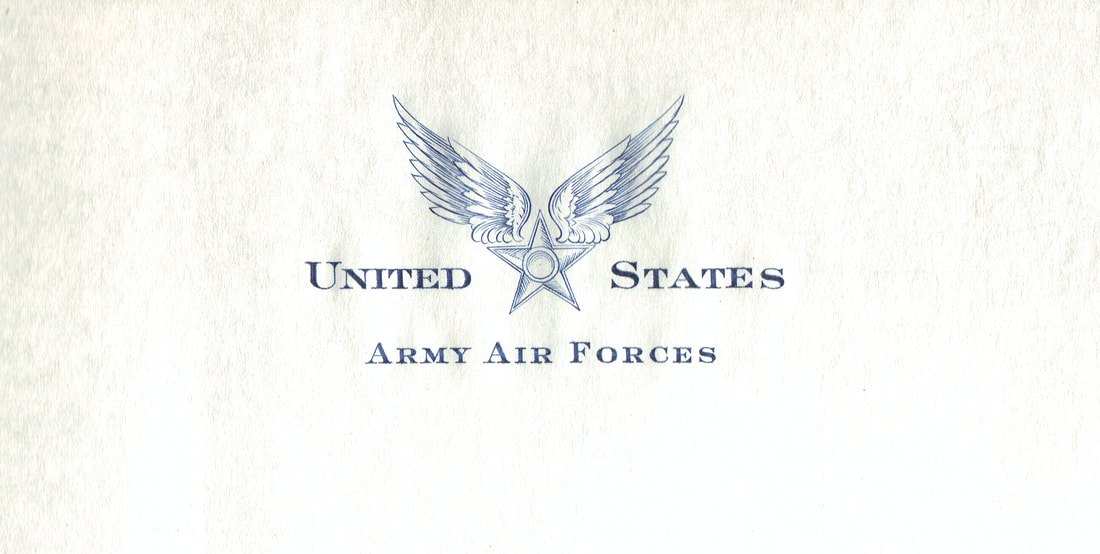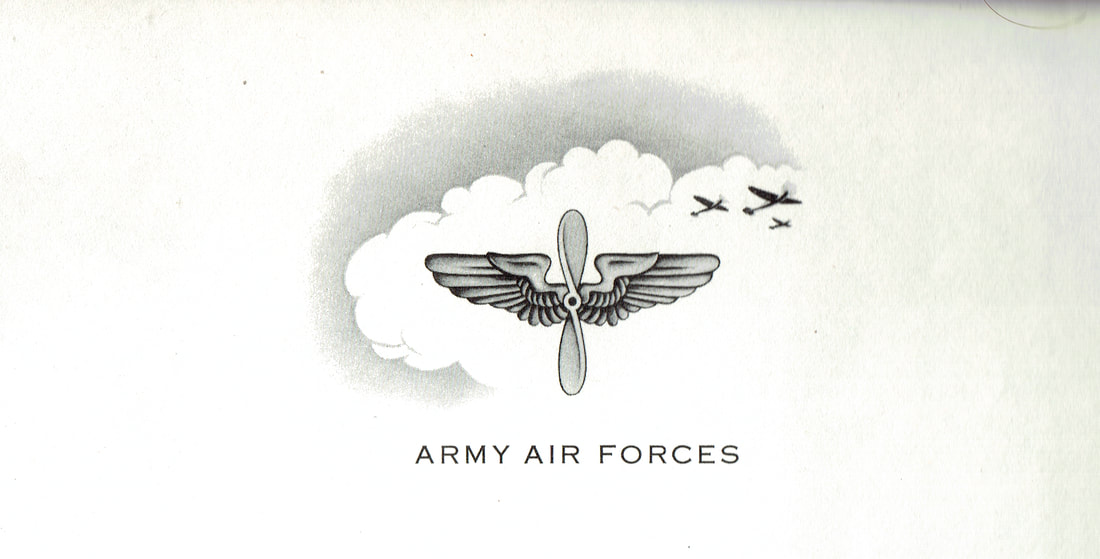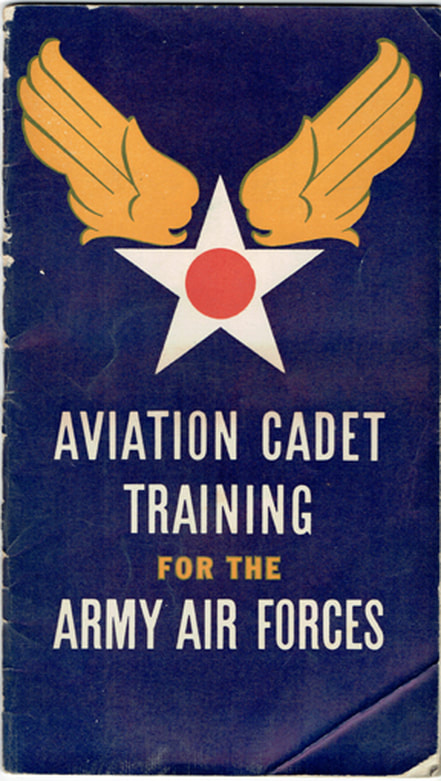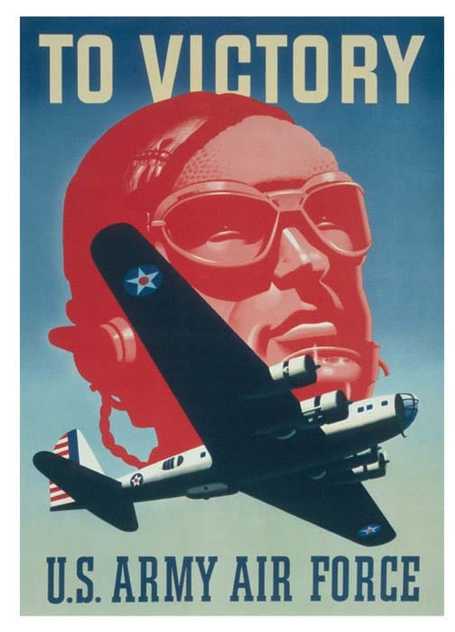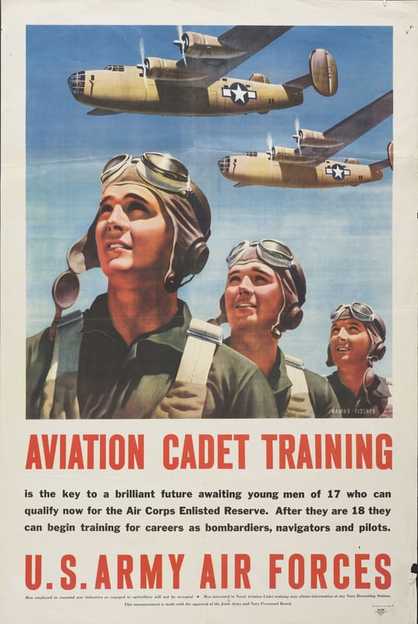Was it the Air Corps or Army Air Forces in WW II?
Executive Order 9082 Reorganizing the Army and the War Department.
February 28, 1942
3. The functions, duties, and powers of the Commanding General, General Headquarters Air Force (Air Force Combat Command), and of the Chief of the Air Corps are transferred to the Commanding General, Army Air Forces.
7. This Order shall become effective on March 9, 1942, and shall remain in force during the continuance of the present war and for six months after the termination thereof.
February 28, 1942
3. The functions, duties, and powers of the Commanding General, General Headquarters Air Force (Air Force Combat Command), and of the Chief of the Air Corps are transferred to the Commanding General, Army Air Forces.
7. This Order shall become effective on March 9, 1942, and shall remain in force during the continuance of the present war and for six months after the termination thereof.
"Even more important than all these innovations however, (1935) was the fact that the Air Corps, as it was known then, was, for the first time, under a unified command, and under an air officer, Major General Frank M. Andrews (later LtG.), whose ultimate death.....brought a major loss to the Army Air Forces." (1)
"By the final reorganization, or 'streamlining', which took place last March, (1942) the Air Corps ceased to exist, even as a purely administrative organization, and the Combat Command was eliminated as well." (1)
"Chiefs of the Air Corps (Now Army Air Forces)" (1)
(1) Gen. HH Arnold, Commanding General, Army Air Forces
(1) Harlingen Army Air Field, Army Air Forces training Command's Wing Over America Yearbook, 1943, published by the Army and Navy Publishing Co. of Louisiana, Baton Rouge, LA, under the auspices of Air Forces Division, War Department Bureau of Public relations, Washington DC, Public Relations Office, Army Air Forces training Command, Public relations Offices, Army Air Forces South east training Center, Army Air Forces Gulf Coast training Center, and Army Air Forces West Coast Training Center. 1943. pp. 7-8 p. 13
"By the final reorganization, or 'streamlining', which took place last March, (1942) the Air Corps ceased to exist, even as a purely administrative organization, and the Combat Command was eliminated as well." (1)
"Chiefs of the Air Corps (Now Army Air Forces)" (1)
(1) Gen. HH Arnold, Commanding General, Army Air Forces
(1) Harlingen Army Air Field, Army Air Forces training Command's Wing Over America Yearbook, 1943, published by the Army and Navy Publishing Co. of Louisiana, Baton Rouge, LA, under the auspices of Air Forces Division, War Department Bureau of Public relations, Washington DC, Public Relations Office, Army Air Forces training Command, Public relations Offices, Army Air Forces South east training Center, Army Air Forces Gulf Coast training Center, and Army Air Forces West Coast Training Center. 1943. pp. 7-8 p. 13
"By March 2, 1942, the War Department announced that the President had approved a reorganization of the War Department and the Army, effective March 9, 1942. The new streamlined organization provided under the Secretary of War and the Chief of Staff a War Department General Staff, a Ground Force, an Air Force and a Services of Supply Command. all with headquarters in Washington." (2)
"Under that set-up, Lieutenant General Henry H. Arnold became Commanding General, Army Air Forces, dropping his former Titles of Chief of the Army Air Forces and Deputy Chief of Staff for Air. The functions, duties and powers of the Commanding General, Air Force Combat Command, and the Chief of the Air Corps were transferred to the jurisdiction of the Commanding General, Army Air Forces." (2)
"With the elimination of the Air Corps as such and the Combat Command, the streamlined organization consisted of an Air Staff as outlined previously in this chapter, a series of numbered Air Forces (1st, 2nd, 8th, 14th, etc.) and several specialized commands (technical Training Command, Flying Training Command, Ferrying Command as previously described)." (2)
(2) The Aircraft Year Book For 1942, (24th Annual Edition) Mingus, Howard, Editor, Copyright 1942, Aeronautical Chamber of Commerce of America, Inc. New York, NY. pp 41-42.
"Under that set-up, Lieutenant General Henry H. Arnold became Commanding General, Army Air Forces, dropping his former Titles of Chief of the Army Air Forces and Deputy Chief of Staff for Air. The functions, duties and powers of the Commanding General, Air Force Combat Command, and the Chief of the Air Corps were transferred to the jurisdiction of the Commanding General, Army Air Forces." (2)
"With the elimination of the Air Corps as such and the Combat Command, the streamlined organization consisted of an Air Staff as outlined previously in this chapter, a series of numbered Air Forces (1st, 2nd, 8th, 14th, etc.) and several specialized commands (technical Training Command, Flying Training Command, Ferrying Command as previously described)." (2)
(2) The Aircraft Year Book For 1942, (24th Annual Edition) Mingus, Howard, Editor, Copyright 1942, Aeronautical Chamber of Commerce of America, Inc. New York, NY. pp 41-42.
"The U.S. Army Air Forces" (3)
"Two Years after Pearl Harbor we have reached the moment when the basic change in our strategic position has become apparent to all. The Army Air Forces are now in the process of fulfilling an historic and decisive mission." (3)
"Blueprints for Air Power" (3)
"The resourcefulness and energy of our people would have been of little avail against our enemies if The Army Air Forces had not begun preparations for war long before Pearl Harbor." (3)
"In the nineteen-thirties, when air power was the unseen guest at those grim conferences which marked the Nazi march to power, the Army Air Corps, which preceded the Army Air Forces, had drawn its blueprints for war." (3)
H.H. Arnold
General, U.S. Army
Commanding General, Army Air Forces
(Report to the Secretary of War, January 4, 1944.) (3)
(3) Report of the Commanding General of the Army Air Forces to the Secretary of War, January 4, 1944. Schneidereith & Sons, Baltimore, MD. pp. 2-3
(Also) Air News Yearbook Volume 2, (First Edition) edited by Andrews, Phillips. Duell, Sloan & Pearce, Inc. New York, NY. Copyright, 1944. p. 3
"Two Years after Pearl Harbor we have reached the moment when the basic change in our strategic position has become apparent to all. The Army Air Forces are now in the process of fulfilling an historic and decisive mission." (3)
"Blueprints for Air Power" (3)
"The resourcefulness and energy of our people would have been of little avail against our enemies if The Army Air Forces had not begun preparations for war long before Pearl Harbor." (3)
"In the nineteen-thirties, when air power was the unseen guest at those grim conferences which marked the Nazi march to power, the Army Air Corps, which preceded the Army Air Forces, had drawn its blueprints for war." (3)
H.H. Arnold
General, U.S. Army
Commanding General, Army Air Forces
(Report to the Secretary of War, January 4, 1944.) (3)
(3) Report of the Commanding General of the Army Air Forces to the Secretary of War, January 4, 1944. Schneidereith & Sons, Baltimore, MD. pp. 2-3
(Also) Air News Yearbook Volume 2, (First Edition) edited by Andrews, Phillips. Duell, Sloan & Pearce, Inc. New York, NY. Copyright, 1944. p. 3
Above research and Red highlights by Paul R. Martin III, 2019.
Much post 1942 physical evidence, including official equipment, posters, documentation, and other period artifacts, are pictured below, along with an essay by Air Force Historian C. C. Elebash Colonel (Retired), U.S. Air Force. (2002)
"In honoring Army Aviation in WW II, the most appropriate and inclusive identification is Army Air Forces!"
C. C. Elebash Colonel (Retired), U.S. Air Force. (2002)
C. C. Elebash Colonel (Retired), U.S. Air Force. (2002)
Above. Army Air Forces letterheads, 1943 (from the Paul Martin collection)
|
Persistent Questions About WW II Army Aviation
Was it the Air Corps or Army Air Forces in WW II? By Clarence C. Elebash Colonel (Retired), U.S. Air Force - January 2002 (used by permission) (Revised June 2010) Over 60 years after the end of World War II, there is still confusion over whether the wartime Army aviation organization was the Air Corps or the Army Air Forces. There also is a lingering debate over whether or not WW II Army aviation was autonomous. These matters came up again with a group of Northwest Florida citizens planning for a World War II Memorial in Pensacola, Florida. The memorial will honor soldiers, sailors, airmen and marines of all military services. The following question arose during planning for the memorial: should Army aviation in WW II be identified as the Air Corps or as the Army Air Forces? This is not a new question. It is a “frequently asked question” by people interested in the history of military aviation. The following paragraphs explain the situation and summarize the background. Hopefully, they clarify the situation and provide satisfactory answers. U.S. Army personnel have traditionally been assigned to branches: Infantry, Artillery, Air Corps, Quartermaster Corps, Corps of Engineers, etc. Branches were generally responsible for training and materiel, although their roles changed from time to time. Operational commands, such as combat divisions and corps, integrated personnel from multiple branches; e.g., Infantry, Artillery, Quartermaster and so on. The Air Corps became the branch for Army aviation in 1926. A few years later, in 1935, General Headquarters (GHQ) Air Force was created for operational aviation units. This arrangement existed in the period leading up to United States entry into WW II. There now were two aviation organizations: the Air Corps managed materiel and training and GHQ Air Force had operational units. This arrangement existed in the period leading up to WW II. |
Training Pamphlet: 8-7-1943 (from the Paul Martin collection)
|
The Army Air Forces (AAF) came into being on June 20, 1941, six months before Pearl Harbor. As war approached, Secretary of War Henry L. Stimson and Army Chief of Staff George C. Marshall saw the need for a stronger and much larger role for Army aviation. Consequently they created the Army Air Forces with General H. H. (Hap) Arnold as its head.
Army Air Forces attained quasi autonomy in March 1942, a few months after the U S entered the war. Acting under authority of the War Powers Act, Secretary Stimson approved a major War Department reorganization. Army Air Forces and Army Ground Forces were made co-equal commands. Significantly, as Commanding General of the AAF, General Arnold became a member of the WW II Joint Chiefs of Staff along with the Army Chief of Staff (General Marshall), the Chief of Naval Operations (Admiral Ernest J. King), and President Roosevelt’s principal military adviser (Admiral William D. Leahy).
The AAF expanded rapidly. It initially had two subordinate organizations, the Air Corps for training and materiel and Air Force Combat Command (replacing GHQ Air Force) for operational forces. As the wartime build-up proceeded, more commands were added -- Flying Training Command, Technical Training Command, Ferrying Command, the numbered air forces and so on.
In the course of wartime expansion and reorganization, the Air Corps ceased to be an operating organization. All elements of Army aviation were merged into the Army Air Forces. Although the Air Corps still legally existed as an Army branch, the position of Chief of the Air Corps was left vacant, and the Office of the Chief of the Air Corps was dissolved.
The Army Air Forces thus replaced the Air Corps as the Army aviation arm and -- for practical purposes -- became an autonomous service. All World War II Army aviation training and combat units were in the AAF. About 2.4 million men and women served in the AAF. Around 600,000 of these were members of other branches, such as Engineers, Ordnance and Quartermaster. Although nominally a part of the Army, the AAF was largely independent.
(The official history published after the war is entitled The Army Air Forces in World War II.)
World War II Air Corps personnel had a strong sentimental attachment to their branch. The Air Corps had an aura about it that seemed to set it apart from other Army branches. Now, sixty years later, many WW II servicemen still proudly identify themselves as veterans of the Air Corps. However -- although the Air Corps was their branch -- they actually served and fought in the WWII Army Air Forces!
Continued below:
Army Air Forces attained quasi autonomy in March 1942, a few months after the U S entered the war. Acting under authority of the War Powers Act, Secretary Stimson approved a major War Department reorganization. Army Air Forces and Army Ground Forces were made co-equal commands. Significantly, as Commanding General of the AAF, General Arnold became a member of the WW II Joint Chiefs of Staff along with the Army Chief of Staff (General Marshall), the Chief of Naval Operations (Admiral Ernest J. King), and President Roosevelt’s principal military adviser (Admiral William D. Leahy).
The AAF expanded rapidly. It initially had two subordinate organizations, the Air Corps for training and materiel and Air Force Combat Command (replacing GHQ Air Force) for operational forces. As the wartime build-up proceeded, more commands were added -- Flying Training Command, Technical Training Command, Ferrying Command, the numbered air forces and so on.
In the course of wartime expansion and reorganization, the Air Corps ceased to be an operating organization. All elements of Army aviation were merged into the Army Air Forces. Although the Air Corps still legally existed as an Army branch, the position of Chief of the Air Corps was left vacant, and the Office of the Chief of the Air Corps was dissolved.
The Army Air Forces thus replaced the Air Corps as the Army aviation arm and -- for practical purposes -- became an autonomous service. All World War II Army aviation training and combat units were in the AAF. About 2.4 million men and women served in the AAF. Around 600,000 of these were members of other branches, such as Engineers, Ordnance and Quartermaster. Although nominally a part of the Army, the AAF was largely independent.
(The official history published after the war is entitled The Army Air Forces in World War II.)
World War II Air Corps personnel had a strong sentimental attachment to their branch. The Air Corps had an aura about it that seemed to set it apart from other Army branches. Now, sixty years later, many WW II servicemen still proudly identify themselves as veterans of the Air Corps. However -- although the Air Corps was their branch -- they actually served and fought in the WWII Army Air Forces!
Continued below:
U. S. Army Air Forces Recruitment posters
While officially the air arm was the Army Air Forces, the term Air Corps persisted colloquially among the public as well as veteran airmen; in addition, the singular Air Force often crept into popular and even official use, reflected by the designation Air Force Combat Command in 1941–42.[n 12] This misnomer was also used on official recruiting posters (see image above) and was important in promoting the idea of an "Air Force" as an independent service. Jimmy Stewart, a Hollywood movie star serving as an AAF pilot, used the terms "Air Corps" and "Air Forces" interchangeably in the narration of the 1942 recruiting short "Winning Your Wings". The term "Air Force" also appeared prominently in Frank Capra's 1945 War Department indoctrination film "War Comes to America", of the famous iconic "Why We Fight" series. In honoring Army aviation in WW II, the most appropriate and inclusive identification is Army Air Forces.
Endnote: The Army Air Forces existed until Congress established the United States Air Force (USAF) in 1947. The new U.S. Air Force absorbed personnel from the Air Corps and from other Army branches who had been serving in the AAF. This occurred after protracted and sometimes bitter debate among the services. Congressional ground, sea and air advocates were deeply involved. The resulting 1947 National Security Act confirmed Air Force autonomy. It divided the War Department into the Department of the Army and the Department of the Air Force. The new U.S. Air Force absorbed members of the Air Corps and personnel from other Army branches who had been serving in the Air Forces.
U.S. Air Force Chronology
1907 Aeronautical Division, Army Signal Corps
1914 Aviation Section, Army Signal Corps
1918 U.S. Army Air Service
1926 U.S. Army Air Corps
1935 Army Air Corps and General Headquarters (GHQ) Air Force
1941 U.S. Army Air Forces
1947 U.S. Air Force
References:
The Army Air Forces in World War II, seven volume official history, edited by Wesley Frank Craven and James Lea Cate, Office of Air Force History, Washington, D.C., New Imprint 1983.
The Birth of the United States Air Force, Air Force Historical Research Agency Web Site, Maxwell Air Force Base, Alabama, October 12, 2001.http://www.maxwell.af.mil/au/afhra/
Hap Arnold and the Evolution of American Airpower, Dik Alan Daso, Smithsonian History of Aviation Series, Smithsonian Institution Press, Washington and London, 2000.
Winged Victory: The Army Air Forces in World War II, Geoffrey Perret, Random House, New York, 1993.ere to edit.
Winged Shield, Winged Sword: A History of the United States Air Force, Volume I (1907-1950), Bernard C. Nalty, General Editor, Air Force History and Museums Program, United States Air Force, Washington, DC, 1997.
March 2002 (Revised June 2010) Author: Clarence C. Elebash is a retired Air Force colonel and professor emeritus at the University of West Florida. He is a graduate of the U.S. Military Academy (1948) (BS), University of Michigan (MBA) and Florida State University (DBA).
Endnote: The Army Air Forces existed until Congress established the United States Air Force (USAF) in 1947. The new U.S. Air Force absorbed personnel from the Air Corps and from other Army branches who had been serving in the AAF. This occurred after protracted and sometimes bitter debate among the services. Congressional ground, sea and air advocates were deeply involved. The resulting 1947 National Security Act confirmed Air Force autonomy. It divided the War Department into the Department of the Army and the Department of the Air Force. The new U.S. Air Force absorbed members of the Air Corps and personnel from other Army branches who had been serving in the Air Forces.
U.S. Air Force Chronology
1907 Aeronautical Division, Army Signal Corps
1914 Aviation Section, Army Signal Corps
1918 U.S. Army Air Service
1926 U.S. Army Air Corps
1935 Army Air Corps and General Headquarters (GHQ) Air Force
1941 U.S. Army Air Forces
1947 U.S. Air Force
References:
The Army Air Forces in World War II, seven volume official history, edited by Wesley Frank Craven and James Lea Cate, Office of Air Force History, Washington, D.C., New Imprint 1983.
The Birth of the United States Air Force, Air Force Historical Research Agency Web Site, Maxwell Air Force Base, Alabama, October 12, 2001.http://www.maxwell.af.mil/au/afhra/
Hap Arnold and the Evolution of American Airpower, Dik Alan Daso, Smithsonian History of Aviation Series, Smithsonian Institution Press, Washington and London, 2000.
Winged Victory: The Army Air Forces in World War II, Geoffrey Perret, Random House, New York, 1993.ere to edit.
Winged Shield, Winged Sword: A History of the United States Air Force, Volume I (1907-1950), Bernard C. Nalty, General Editor, Air Force History and Museums Program, United States Air Force, Washington, DC, 1997.
March 2002 (Revised June 2010) Author: Clarence C. Elebash is a retired Air Force colonel and professor emeritus at the University of West Florida. He is a graduate of the U.S. Military Academy (1948) (BS), University of Michigan (MBA) and Florida State University (DBA).
The Nation's Air Arm in WWII was the Army Air Forces.
However there's more to the story!
By John T. Correll, Editor, AIR FORCE Magazine, July, 2009
